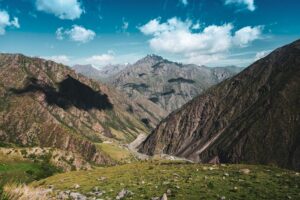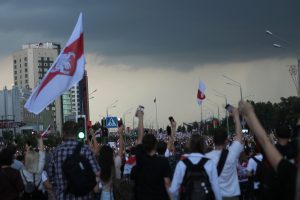European National Policies Series – Norway and Central Asia

Download “European National Policies Series - Norway and Central Asia”
EUCAM-National-Policies-Brief-16.pdf – Downloaded 395 times – 895.43 KBNorway is a peripheral European state, with a population of only five million, but it has an economy that is larger than its population figures would suggest. Although it does not play a particularly prominent role in Central Asia, most likely due to its small size, its distance from the region and its lack of trade complementarities, it has become relatively active in the region, focusing on the fields of energy and good governance. Norway and Norwegian actors have about the same level of involvement as other Nordic countries do in Central Asia. Norway is a far smaller player in the region than the European Union (EU), which accounts for 40 per cent of Central Asia’s trade with the world. One driver of Norwegian interests in the region is the fact that Norway is a direct neighbour of Russia, making Kazakhstan a ‘neighbour’s neighbour’. Norway is also a major petroleum exporter, which gives it an interest in Kazakhstan and Turkmenistan.
Political relations and values
Norway is not a member of the European Union, so it relies mainly on bilateral diplomacy in its relations with the Central Asian states. Kazakhstan is particularly important to Norway, and the only Norwegian embassy in the region is in Astana. The country’s main interest in Kazakhstan lies in the Norwegian companies that participate in the country’s resource extraction industries, most importantly oil and gas, but also mining.
The Norwegian Ministry of Foreign Affairs aims to promote political, economic and cultural ties with the states in Central Asia. This includes cooperation in and through multilateral organisations such as the Organisation for Security and Co-operation in Europe (OSCE), as well as various UN bodies. As it does in other parts of the world, Norway seeks to promote good governance, human rights and democracy. Climate and environmental issues and education are also important areas for development cooperation. Alongside these issues, Norway has interests in energy development through the national energy champion, Statoil, in which the Norwegian state is the majority shareholder.
Norway sent its first resident ambassador to Kazakhstan in 2009, and the Norwegian embassy was officially opened in early 2010 by H.R.H. Crown Prince Haakon and the then minister of foreign affairs, Jonas Gahr Støre. Before that, Norway’s non- resident ambassador to Kazakhstan was based in Oslo. The embassy in Astana also handles Norway’s diplomatic relations with Kyrgyzstan, Tajikistan and Turkmenistan. Kazakhstan opened an embassy in Oslo in 2004, with a non-resident ambassador based in the Netherlands. A permanent Kazakh ambassador will be based in Oslo from 2013.
High-level visits between Kazakhstani and Norwegian officials have increased in recent years, reflecting the growing ties between the two countries. Nuclear disarmament is a shared concern. In March 2013, a large delegation from Kazakhstan participated in a conference in Oslo on the humanitarian consequences of nuclear testing. Norway and Kazakhstan organised a joint conference on the nuclear issue in 2010. Kazakh President Nursultan Nazarbayev visited Norway in 2001 and Secretary of State Kanat Saudabayev was in Oslo in 2009 and 2010. A Kazakh parliamentary delegation working on gender legislation visited Norway in January 2013. Kazakhstan’s Deputy Prime Minister Kairat Kelimbetov, then Minister of Labour and Social Protection Serik Abdenov, and Finance Minister Bolat Zhamishev visited Norway in April 2013 for a conference organised by the International Labour Organisation. Erlan Idrissov, Kazakhstan’s foreign minister, was in Oslo in March 2013. During Idrissov’s visit, on 21 March Norway and Kazakhstan signed a Memorandum of Understanding, which laid out an agreement in principle to establish a bilateral governmental commission. Minister of Environmental Protection Nurlan Kapparov is set to lead the commission from the Kazakhstani side. Norway has not yet decided on a leader, but the minister of trade and industry, Trond Giske, is a likely candidate.
Kjell Magne Bondevik, then Norwegian prime minister, visited Kazakhstan in 2004. Norway’s foreign minister, Jonas Gahr Støre, was in Astana in February and December 2010, and deputy foreign ministers visited Kazakhstan for bilateral talks in 2009 and 2012. Norwegian Minister of Trade and Industry Trond Giske visited the Astana economic forum as recently as May 2013. Norway is leading negotiations on a free trade agreement (FTA) between the European Free Trade Association (EFTA) and Russia, Belarus and Kazakhstan.
Norway has always had closer and more vibrant relations with Kazakhstan than with the other countries in the region, at the diplomatic level, in business and in interactions between the two societies. Norway has, however, been more involved with Kyrgyzstan and Tajikistan in terms of aid and development assistance.
The Norwegian embassy in Moscow covers Norway’s diplomatic relations with Uzbekistan. Uzbekistan’s ambassador in London has been accredited to Norway since 2010. The Norwegian foreign minister visited Uzbekistan in 1999 and the deputy minister of foreign affairs visited in 2002 and 2009. In 2010, Uzbek Deputy Foreign Minister Bobir Tukhtabayev visited Norway. In spite of these official exchanges, there is relatively little contact between the two countries, and relations have sometimes been cold.
Norwegian foreign ministers have visited Tajikistan twice. The first visit took place in 1999, when Norway chaired the OSCE, and the second was a bilateral visit in 2004. A Norwegian OSCE Parliamentary Assembly delegation visited Tajikistan in 2012. The Tajikistani minister of energy visited Norway in November 2012. Kyrgyzstan’s first president, Askar Akayev, visited Norway in November 2002. The Norwegian minister of environment visited Kyrgyzstan in 2003, and Kyrgyzstan’s deputy foreign minister, Erines Otorbayev, came to Norway in May 2013.
Bilateral political relations between Norway and Turkmenistan are limited. Turkmenistan does not have an accredited ambassador to Norway. Norway’s deputy minister of petroleum and energy visited the Turkmenistan International Oil and Gas Exhibition in 2007, and Norwegian officials have made several similar visits, but with few results.
Not many asylum-seekers from Central Asia have come to Norway, but some small communities do exist. Several prominent opposition activists, especially from Turkmenistan and Uzbekistan, have spent time in Norway. Former Turkmen Foreign Minister Avdi Kuliyev spent the last years of his life in exile in Oslo, and the leader of the Uzbekistani opposition party Erk, Muhammad Salih, was granted asylum in Norway in 1999.
Trade and energy
Kazakhstan is interested in Norway because it is an energy- producing country with an advanced and diversified economy. Kazakhstan’s green energy strategy, which received presidential backing at the 2013 Astana Economic Forum, has created further opportunities for cooperation.
Trade between Norway and the Central Asian countries grew for several years, but has dropped lately. This can be explained by fluctuations in investments in oil and gas projects. It is also possible that the figures may be misleading and that Kazakhstani-Norwegian trade may actually not have decreased, since most Norwegian fish sold in Kazakhstan is re-exported through Russia and Belarus. Reliable data on this is difficult to obtain.
Norway’s main trade partner in Central Asia is Kazakhstan. Several Norwegian companies have established a presence in Kazakhstan’s energy sector. At its highest point in 2008, total trade was worth €311 million, with €289 million of this figure accounted for by Norwegian exports. In 2012, trade values sank dramatically to €32 million, largely because of reductions in Norway’s export of industrial machinery and equipment. The main export item is now fish and fishery products, which made up 62 per cent of total Norwegian exports to Kazakhstan in 2012. Exports in this sector have become more problematic in recent years, after a series of spats between Norway and Russia over fishery products.(1) Norway also exports iron and steel to Kazakhstan and imports non-ferrous metals and grain products. Durum wheat – the main ingredient in pasta – accounts for 99 per cent of Kazakhstani exports to Norway. In 2006, Norway exported products worth €19.4 million to Turkmenistan, but by 2012 total trade turnover was only €0.575 million. The reasons for this drop are not clear.
Norway is a member of the European Free Trade Association (EFTA) and is leading EFTA negotiations with the Customs Union (CU) of Russia, Belarus and Kazakhstan on an FTA between the two regions. The eighth round of negotiations was held in April 2013. Norway is very interested in finalising a free trade agreement with Russia, which is its largest trade partner outside the EU. After the establishment of the CU in January 2010, Kazakhstan and Belarus were included in the negotiations. The aim is a ‘modern free trade agreement including goods, services, public procurements and intellectual property rights’, and talks began in January 2011.(2) Norway has made it clear that all three countries have to be members of the World Trade Organisation (WTO) before the agreement can be ratified. At present, only Russia fulfils this criterion. In May 2013, Norwegian Minister of Trade and Industry Trond Giske stated that the partners aim to finalise the agreement this year.
Most Norwegian companies active in the region operate in the petroleum sector and are oriented towards the Kazakh market. They are mainly supply companies and sub-contractors such as Aker Solutions and Det Norske Veritas. During his official visit to Kazakhstan in 2010, Foreign Minister Støre highlighted energy cooperation, as well as Norway’s experience in developing and managing petroleum resources. INTSOK, a trade association that works to promote Norwegian oil and gas companies abroad, has an office in Kazakhstan with one local employee.
The Norwegian state-controlled oil company, Statoil, is the second-largest foreign company in Azerbaijan. It has shown substantial interest in expanding its operations eastwards to Kazakhstan and Turkmenistan and has set up offices in both countries. So far, it has not succeeded in gaining access to attractive oil or gas fields. In February 2013, after seven years of negotiations, the company announced that it had decided not to continue negotiations with Kazakhstan’s Kazmunaigas over the Abai exploration project.(3)
The Norwegian aluminium producer, Hydro, signed an agreement in 2000 to supply alumina to the Tajik Aluminium Company (TALCO) in Tajikistan. In 2004, however, Tajik Aluminium started negotiating with the Russian aluminium company RUSAL, and after January 2005, Hydro no longer received aluminium from Tajikistan. Hydro took the Tajik company to the London Court of International Arbitration in February 2005, and in 2006 the court confirmed that Tajik Aluminium had to compensate Hydro for its losses. Later in 2006, however, TALCO made a deal directly with Hydro, and the Norwegian company was invited back in as a supplier for Tajik Aluminium from December 2006. The contract reportedly ended in 2010, but according to one Central Asian expert, TALCO has continued to use Hydro as a supplier of alumina.(4) The two companies also signed a strategic partnership agreement for 2010-2013. In 2012, Norway imported aluminium worth almost €27 million from Tajikistan, although this figure represented a major drop from €47 million in 2009.(5)
Norway’s trade and investment relations with Kyrgyzstan and Uzbekistan are insignificant. In 2011, Norway exported seafood worth just under €1 million to Uzbekistan and imported pepper totalling €64,000.
The Norwegian telecoms company Telenor is a major shareholder in the Russian company Vimpelcom, which in turn owns shares in companies in Kazakhstan and Uzbekistan. In 2012, a series of long, critical articles were published in Norway’s largest business newspaper, Dagens næringsliv. These articles criticised the company for its investment in Kazakhstan and Uzbekistan, and argued that its technology could be used by authorities to carry out surveillance and suppress political opposition. This was a significant public relations blow for Telenor, although it is not clear whether it has had any direct consequences in terms of ownership or finances.
Security
As a NATO member, since 2002 Norway has actively contributed to the International Stability Force in Afghanistan (ISAF). Since 2005, Norwegian forces have mainly been deployed in northern Afghanistan, in Faryab province, which borders on Turkmenistan, and Balkh, which borders on Uzbekistan. The Norwegian camp in Meymaneh, Faryab, was handed over to Afghan forces on 1 October 2012. The main contribution Norway makes in northern Afghanistan today is through its participation in a Nordic-Baltic police mentoring team in Mazar-e Sharif, Balkh province, along with Sweden, Finland and Latvia.
Norway reaffirmed its support for the Istanbul Process and the Heart of Asia countries in a strategic partnership agreement with Afghanistan in February 2013.(6) Norway is also participating in confidence-building measures on disaster management.
Because it is not a member of the EU, Norway has sometimes found itself on the sidelines of pan-European interaction and initiatives, including those relating to the former Soviet Union. This may be one reason why Norway has been more active than many other member countries in the OSCE, including in the organisation’s work in Central Asia. Norway is also close to the other Nordic countries, which are EU members: in Astana, Norway’s embassy shares a building with Sweden and Finland. Norway pursues its interests bilaterally, especially with Kazakhstan, but it often aligns with the EU, as for example in the statements on the political situation in Kyrgyzstan during the 2010 crisis in the south of the country.(7)
Development assistance
Norway focuses on a few selected partner countries in official development assistance (ODA) and humanitarian aid. Although Afghanistan is a major recipient country of Norwegian aid, Central Asia is not among the regions prioritised for aid. Norwegian support to the Central Asian states is directed mainly through international financial institutions such as the European Bank for Reconstruction and Development (EBRD), and through international organisations such as the OSCE, the International Organisation for Migration (IOM) and various UN bodies. Norway is a strong supporter of the OSCE in the region and backs several projects through the organisation, such as the OSCE Academy in Bishkek.
Kim Traavik, state secretary (deputy minister) of foreign affairs from 2001 to 2005, contributed to a marked orientation towards Central Asia in Norwegian foreign policy during his time in office. Traavik is a career diplomat who served as the ambassador responsible for the preparations for and implementation of Norway’s chairmanship of the OSCE in 1999, which seems to have influenced his priorities as state secretary.
Norway has been particularly engaged in the education sector in the region, with educational exchange and cooperation projects in fields ranging from geology and ecotourism to the social sciences. Cooperation has especially focused on vocational education programmes.(8)
Afghanistan was the second largest recipient of Norwegian aid in 2012, after Brazil. Norway’s involvement in Afghanistan has influenced Norwegian projects in Central Asia; projects have been set up on cross-border cooperation and trade between Tajikistan and Afghanistan. Norway supports the United Nations Office for Drug Control (UNODC) in Tajikistan, which aims to strengthen Tajikistan’s ability to counter the flow of narcotics from Afghanistan. Norwegian officials see the drug trade as one of the key challenges for the Central Asian states, describing Central Asia as a ‘first line defender against many of the transnational threats to our common security’.(9) Working through the OSCE, the Norwegian government has been a key contributor to border control training. It also collaborates with the Aga Khan Foundation on projects involving cross-border electricity supplies. And Norway has provided some of the funds for the construction of the Nizhniy Pyanj Friendship Bridge between Afghanistan and Tajikistan. Since 2010, Norwegian People’s Aid has been clearing mines on the Afghan-Tajik border and training dogs for mine clearance.
Norwegian aid is also allocated to water management and energy efficiency programmes. More generally, Norway seeks to foster democratic governance and human rights. A Tajik- Norwegian Small Hydropower Development Centre was established in 2010.(10) Between 2000 and 2010, Norwegian development assistance to Central Asia increased from around €3 million to €12 million.(11) In 2000, the largest aid recipient was Tajikistan, whereas in 2010, Kyrgyzstan received the highest share. Uzbekistan and Turkmenistan have received 1 and 3 per cent, respectively, of total Norwegian assistance to Central Asia.
Some Norwegian non-governmental organisations have been active or are currently represented in Central Asia. The Norwegian Helsinki Committee has an office in Kazakhstan, and the Norwegian Refugee Council has worked in Kyrgyzstan and Tajikistan. Norwegian groups are also involved in environmental protection, for example through the Norwegian Society for the Conservation of Nature, which has a regional programme in Central Asia, including exchange programmes between environmental organisations. The Norwegian embassy in Astana maintains a small grants programme for civil society actors and organisations in Central Asian countries.
Conclusion
Central Asia has become more important, mainly due to its role as a source of oil and gas, and due to the conflict in Afghanistan. As a result, Norway has developed its political ties to the region. Efforts to achieve closer relations are partly driven by the interests of Norwegian companies participating in oil and gas extraction in Kazakhstan and Turkmenistan. So far, this effort has borne little fruit and it is unclear whether Norwegian engagement with the region will continue expanding. Future engagement depends on the security situation in the region after the drawdown of the international military presence in Afghanistan, as well as on political developments in the Central Asian states.
- See statement on the embassy website: Royal Norwegian Embassy in Kazakhstan, ‘Eksport av fisk til Kasakhstan’, available at: http://www.norvegia.kz/Norsk/kasakhstan/handel-og-investering/Sertifikat-for-eksport-av-sjomat-til-Kasakhstan/ [accessed 29 May 2013].
- See Ministry of Trade and Industry, ‘Russland, Hviterussland og Kasakhstan’, Regjeringen.no, 2013, available at: http://www.regjeringen.no/en/dep/nhd/selected-topics/free-trade/partner-land/russland.html?id=482397 [accessed 11 June 2013].
- N. Gizitdinov, ‘Statoil Abandons Kazakh Caspian Oil Project After 7 Years’, Bloomberg, 13 February 2013, available at: http://www.bloomberg.com/news/2013-02-13/statoil-abandons-kazakh-caspian-oilfield-project-after-7-years.html [accessed 29 May 2013].
- M. B. Olcott, Tajikistan’s Difficult Development Path (Washington D.C.: Carnegie Endowment for Peace, 2012), p. 207.
- Information calculated from StatBank of Statistics Norway. Statistics Norway, ‘StatBank Norway’, available at: https://www.ssb.no/en/statistikkbanken [accessed 11 June 2013].
- J. Stoltenberg and H. Karzai, ‘Agreement on Strategic Partnership between the Kingdom of Norway and the Islamic Republic of Afghanistan’, Regjeringen.no, 5 February 2013, available at: http://www.regjeringen.no/upload/UD/Vedlegg/Utvikling/avtale_norge_afgh_2013.pdf [accessed 2 June 2013].
- See OSCE, ‘EU statement on Kyrgyzstan’, OSCE Permanent Council No. 830, Vienna, 23 September 2010, available at: http://www.osce.org/pc/71448 [accessed 11 June 2013].
- See for example RKK, a resource center for vocational secondary schools working in Kazakhstan. RKK Kazakhstan, ‘Kazakhstan’, RKK.no, available at: http://www.rkk.no/en/INTERNATIONAL/Kazakhstan [accessed 4 June 2013].
- Permanent Delegation of Norway to the OSCE, ‘Statement by Norway in Response to the EU Special Representative for Central Asia Patricia Flor’, Norway: The Permanent Delegation to the OSCE, 11 April 2013, available at: http://www.norway-osce.org/Global/PC.DEL_0211_13%20-%20Statement%20by%20Norway%20in%20Respone%20to%20the%20Address%20by%20Amb.%20Flor,%20EU%20Special%20Representative%20for%20Central%20Asia.pdf [accessed 11 June 2013].
- Central Asia Newswire, ‘New group promotes private sector hydropower in Tajikistan’, Universal Newswires, 3 December 2010, available at: http://www.universalnewswires.com/centralasia/viewstory.aspx?id=2536 [accessed 11 June 2013].
- See Norwegian Agency for Development, ‘Norsk bistand i tall’, Norad, 2013, available at: http://www.norad.no/bistanditall/main.html [accessed 26 May 2013].
Download “European National Policies Series - Norway and Central Asia”
EUCAM-National-Policies-Brief-16.pdf – Downloaded 395 times – 895.43 KB






